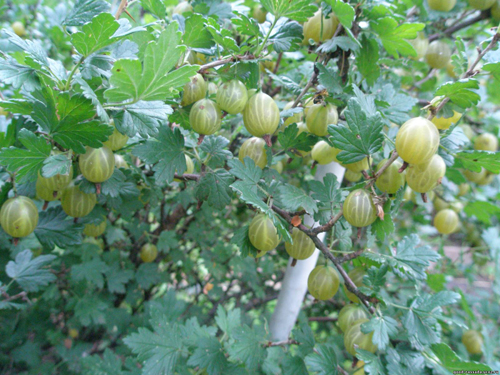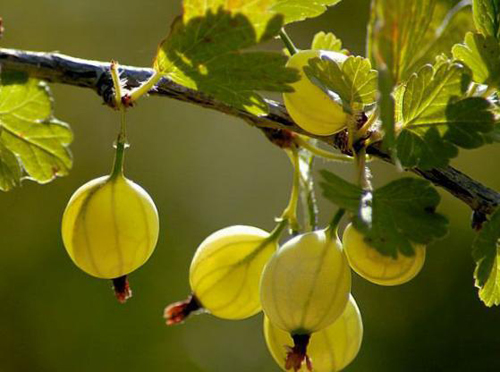Gooseberry variety Russian yellow
The creation of new varieties of gooseberries does not only occur through pollination of various species. Sometimes planted cuttings show characteristics that are different from the base variety. This happened with Russian yellow, which is a kidney variation of the well-known red-fruited variety. Russian... The author of the new yellow-fruited clone was K.D. Sergeeva. In 1963, the novelty was announced by the Federal State Budgetary Scientific Institution “Federal Scientific Center named after I.V. Michurin ". Our hero was included in the State Register of Breeding Achievements in 1974. Regions of admission - Ural (Chelyabinsk, Orenburg, Kurgan regions and the Republic of Bashkortostan) and North-West (Yaroslavl, Vologda, Pskov, Kaliningrad, Tver, Kostroma, Novgorod, Leningrad regions). After the tests carried out, the variety was zoned in the Leningrad, Yaroslavl and Kharkov regions. Can be used for industrial cultivation.
Description
The plant is medium-sized, a little over a meter high, differs from the parent by weak branching and not too thickened crown. As a result, the gooseberry bush grows moderately spreading. The growing shoots of the Russian yellow are thick, not pubescent, with hanging tops, the bark is light green, in the upper part of the shoot it turns pink. Lignified shoots of normal thickness, light bark. The spine of the shoots is moderate. There are up to 96 thorns on 10 basal shoots. The thorns are predominantly single, of medium thickness, 0.9 cm long, light-colored, straight, growing perpendicular to the shoot or obliquely upward. Localized mainly in the lower part of the shoot. The buds of the variety are small, oblong, with a blunt apex, not pubescent, brown in color, growing deviating from the shoot.

Gooseberry leaves are of normal size, bright green in color, not pubescent, with a folded and slightly shiny leathery surface, flat or slightly concave. The shape of the leaf plate is five-bladed, the notches between the blades are not too large, the middle blade rises slightly above the lateral ones. The lateral lobes are small, pointed, the apices are obtuse, directed upward, the angle between the veins of the lateral lobes is acute. The teeth are small, obtuse, slightly bent. The main veins are uncolored. The basal lobes are poorly developed, with open veins. The base of the leaf is straight or slightly heart-shaped, the angle between the petiole and the base of the leaf is straight or obtuse. The petiole is of normal length and thickness, in the lower part it is covered with very sparse glandular pubescence, attached at an angle of 45 ° to the shoot. A rounded scar remains at the point of separation of the leaf from the shoot. The flowers of the Russian yellow are pale-colored, medium-sized. The sepals of the variety are small, slightly bent upward, often pale, but sometimes have faint traces of anthocyanin coloration at the base and along the edges. The inflorescence is one- or two-flowered. Gooseberry ovary is oval, without edges, glabrous.
Berries are oval or obovate, not pubescent, rather large, weighing 4.2 - 5.8 grams (according to the State Register, 5 - 7 grams). Based on the results of 15-year research, it turned out that the average weight of berries over these years was 5.2 grams, and in dry years the fruits weighed about 2.1 grams, in cold and wet years, the weight increased to 4.4 grams. During the ripening period, the berries turn yellow or yellowish-greenish in color and become almost transparent. The skin is medium-thick, with a waxy coating and strong venation; the veins are weakly branched, lighter than the main color of the fruit. The calyx is full, large, closed. The peduncle is short or medium, thin, without traces of pubescence, light green. The pulp is juicy, tender consistency, the amount of seeds is moderate, the seeds themselves are small. The taste is sweet and sour, the assessment of tasters is 4.0 points, which classifies Russian yellow as a variety of table purposes.The studies of the fruits revealed changes in the ratio of anthocyanins and leukoanthocyanins, a slight increase in the amount of the soluble part of the pectin complex, soluble solids and sugars in comparison with the Russkiy variety. All this in the complex influenced the color of the gooseberry, improved the consistency of the pulp and its taste. 100 grams of raw material contains: the sum of sugars - 9.3%, titratable acids - 2.1%, ascorbic acid - 12.0 - 32.0 mg. Depending on the years, the presence of nutrients in berries can fluctuate up or down, but not significantly.

Characteristics
- Ripening period of Russian yellow is medium. In warm regions, it can ripen in early July, in cool regions - in the middle of the month. This process takes place a week earlier than the Russian;
- the average yield was 13.8 t / ha or 4.1 kg per bush. The maximum figure for the years of testing is 6.2 kg per bush, the minimum is 3.5 kg;
- the immunity of the variety is excellent. Resistance to powdery mildew is very high - damage to vegetative parts in the first years of growth was 0.3 points. The overall indicator for 15 years is 0.1 points. Resistance to septoria blight is slightly lower, but also high - in unfavorable years, lesions were noted by 1.3 - 3.2%. The good health of the culture is also evidenced by numerous reviews;
- gooseberries are characterized by good self-fertility, with self-pollination, the yield is 32.6%. To improve this indicator, it is good to plant nearby suitable pollinators - Russian, Houghton;
- excellent frost resistance - the bush can withstand temperature drops to -28 ° C. During the tests, it was not frozen even once;
- there is good drought tolerance;
- Russian yellow berries have excellent commercial qualities, when overripe they do not burst or crumble;
- not overripe crop retains its presentation during transportation and storage;
- the way of eating berries is universal. They can be consumed not only fresh, but also made preparations. For example, in compotes, the yellow color of gooseberries is perfectly preserved.

Planting and leaving
The recommended time for planting is late September - early October. The main thing is that at least 3 weeks remain before the onset of stable cold weather. Can be planted in the spring, but before the buds begin to awaken. The variety will show all its qualities only in a well-lit area with a low groundwater level (no higher than 1.5 meters to the surface). Of the soils, nutrient loams with neutral acidity are preferred, which have excellent air and moisture permeability. Despite its resistance to dry periods, Russian yellow responds to irrigation with an increase in the mass of berries. Also useful for the bush and making timely nutrition. The soil under the gooseberry bush should be free of weeds, this will reduce the risk of diseases and infestations of insect pests. Preventive treatments are carried out according to the schedule. In the spring, preventive pruning should not be missed, which reduces the thickening, and therefore increases the illumination of the crown. This in turn raises the level of sugars in the fruit. When planting, you need to maintain a distance of about 2 meters between adjacent bushes.
Russian yellow retained all the positive characteristics of a relative and even improved some indicators (texture and taste of berries). Good yield, self-fertility, commercial quality of fruits and unpretentious care makes it possible to use this gooseberry in industrial plantings. There are few thorns and they are all at the bottom of the shoot, so scratches during harvest can be avoided. Due to the large number of positive characteristics, many gooseberry growers opt for this already proven variety.








